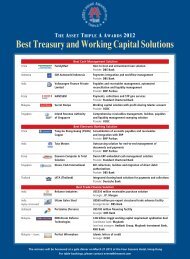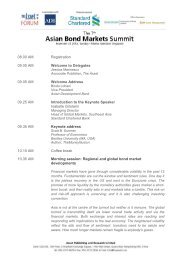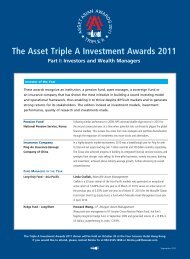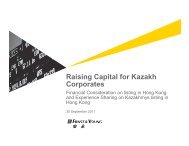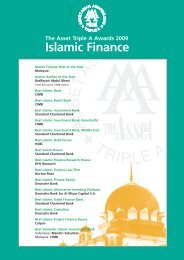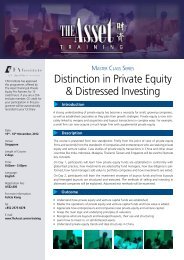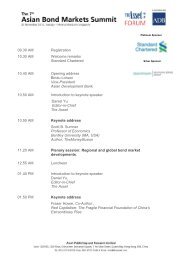China's gas market, Bradley Way, BNP Paribas - The Asset
China's gas market, Bradley Way, BNP Paribas - The Asset
China's gas market, Bradley Way, BNP Paribas - The Asset
Create successful ePaper yourself
Turn your PDF publications into a flip-book with our unique Google optimized e-Paper software.
Opportunities for Kazakh Companies in China’s Gas Market<br />
<strong>Bradley</strong> <strong>Way</strong><br />
Corporate Finance – Energy & Utilities<br />
<strong>BNP</strong> <strong>Paribas</strong><br />
Beijing, China<br />
Mobile: +86 158 1011 3542<br />
bradley.way@asia.bnpparibas.com
Contents<br />
1<br />
2<br />
3<br />
4<br />
<strong>The</strong> Evolution of China’s natural <strong>gas</strong> <strong>market</strong>.<br />
Key issues that will drive demand and impact pricing.<br />
<strong>The</strong> supplier landscape is growing increasingly competitive – key issues driving this.<br />
Opportunities and Strategies for Kazakhstan’s oil & <strong>gas</strong> companies.<br />
21 September 2011<br />
2
Section<br />
<strong>The</strong> Evolution of China’s natural <strong>gas</strong> <strong>market</strong> 1<br />
21 September 2011 3
Key issues that will shape China’s Gas Market<br />
Rapid growth in consumption<br />
China’s natural <strong>gas</strong> <strong>market</strong> has grown from 40 bcm in 2004 to 109 bcm in 2010 – exceeding Japan to become the largest in <strong>gas</strong><br />
consumption in Asia. We expect this to continue, driven by industrial demand, the power sector, and <strong>gas</strong>ification of some portions of<br />
the auto fleet.<br />
NOCs and IOCs<br />
Chinese National Oil Companies (NOCs) are eager to learn exploration and development of unconventional <strong>gas</strong>, they want upstream<br />
equity in LNG projects, and they want to be involved in the managing an LNG project from start to finish. International Oil Companies<br />
(IOCs) have access to these areas, and are making offers. What brings IOCs to China for these deals IOCs are starting to see that<br />
they need a foothold in China in order to <strong>market</strong> their LNG assets in Australia-Asia, and that unconventional <strong>gas</strong> in China could be<br />
potentially quite large. <strong>The</strong>se matching needs are bringing IOCs and China’s NOCs together, and increasing competition for sellers.<br />
Policy is improving<br />
…And this is enabling large scale buyers to emerge in the electrical power and automotive spaces. Policy support is underpinning the<br />
emergence of a <strong>market</strong> outside of industrial and residential <strong>gas</strong>.<br />
Timing is crucial for Kazakh<br />
and Central Asian companies<br />
Major changes in cost of supply, volume of supply, and the competitive landscape are now in motion. Neighbouring <strong>gas</strong> exporters need<br />
to be financially and strategically equipped to seize opportunities.<br />
21 September 2011<br />
4
China’s Gas Market: from small, to Asia’s largest, in just a few years<br />
Gas Consumption 2004 (bcm) Asia <strong>market</strong> share<br />
China 39.7 14%<br />
India 31.9 12%<br />
Indonesia 32.2 12%<br />
Japan 77.0 28%<br />
Malaysia 24.7 9%<br />
South Korea 28.4 10%<br />
Taiwan 10.2 4%<br />
Thailand 29.9 11%<br />
Total 274.0 100%<br />
Gas Consumption 2010 (bcm) Asia <strong>market</strong> share<br />
China 109.0 25%<br />
India 61.9 14%<br />
Indonesia 40.3 9%<br />
Japan 94.5 21%<br />
Malaysia 35.7 8%<br />
South Korea 42.9 10%<br />
Taiwan 14.1 3%<br />
Thailand 45.1 10%<br />
Total 443.5 100%<br />
• China’s <strong>gas</strong> <strong>market</strong> started to see material growth in 2004,<br />
when town-<strong>gas</strong> policy was promulgated, officially<br />
forbidding coal from being burned in homes.<br />
• <strong>The</strong> policy included a country-wide rollout plan for<br />
connecting people’s homes to <strong>gas</strong> for cooking and hot<br />
water, which is now in motion in 3rd and 4th tier cities.<br />
• Residential <strong>gas</strong> alone has taken China’s <strong>market</strong> to over<br />
100bcm pa, exceeding Japan in consumption. <strong>The</strong><br />
industrial sector is also gradually switching from liquid<br />
fuels to natural <strong>gas</strong> for boilers and heat applications.<br />
• Other large areas of consumption include <strong>gas</strong>-fired power<br />
and <strong>gas</strong> in automobiles.<br />
Source: BP statistical yearbook<br />
21 September 2011<br />
5
Competition is increasing – exporters need a foothold in the <strong>market</strong><br />
Confirmed import supply contracts<br />
Import supply contracts under negotiation<br />
Source Type Project / Route Buyer Start End<br />
Total volume<br />
booked to date<br />
(bcm)<br />
Australia LNG Gorgon PetroChina 2014 2034 3.1<br />
Australia LNG Gorgon PetroChina 2014 2034 2.7<br />
Australia LNG North West Shelf CNOOC 2006 2008 2.2<br />
Australia LNG North West Shelf CNOOC 2008 2025 4.5<br />
Australia LNG QCLNG CNOOC 2014 2034 4.9<br />
Indonesia LNG Tangguh CNOOC 2009 2033 3.5<br />
Malaysia LNG MLNG Dua Shanghai LNG 2009 2033 2.4<br />
Malaysia LNG MLNG Tiga Shanghai LNG 2009 2033 1.7<br />
Papua New<br />
Guinea LNG PNG LNG Sinopec 2014 2034 2.7<br />
Qatar LNG Qatar<strong>gas</strong>-2 CNOOC 2009 2010 0.7<br />
Qatar LNG Qatar<strong>gas</strong>-3 CNOOC 2010 2034 2.7<br />
Qatar LNG Qatar<strong>gas</strong>-4 PetroChina 2011 2036 4.1<br />
Yemen LNG Yemen LNG CNOOC 2010 2024 1.4<br />
Turkmenistan<br />
Piped<br />
Turkmenistan -<br />
China PetroChina 2010 2030 30.0<br />
Myanmar Piped Myanmar - China PetroChina 2013 2040 7.0<br />
Total capacity booked to date (bcm) 73.6<br />
Total domestic production (bcm) 97.0<br />
Total <strong>gas</strong> supply (bcm) 170.6<br />
Source Type Project / Route Buyer Start End<br />
Total<br />
possible<br />
volume (bcm) Agreement type<br />
Australia LNG APLNG Sinopec 2011 20 yr 6.0 HoA<br />
Australia LNG Wheatstone CNPC n/a n/a n/a MoU<br />
Australia LNG ALNG CNPC n/a n/a 10.1 50% equity stake<br />
Australia LNG Gladstone (LNGL) CNPC n/a n/a n/a 19.9% equity stake<br />
Iran LNG Pars CNPC n/a n/a 4.2 Hoa<br />
Kazakhstan<br />
Piped Urikhtau<br />
(Beyneu - Shymkent)<br />
CNPC n/a n/a n/a Signed agreement<br />
for JV with KMG<br />
Qatar LNG Qatar<strong>gas</strong>-3 CNOOC 2013 2037 4.1 Mou<br />
Qatar LNG Qatar<strong>gas</strong>-4 PetroChina 2014 2038 2.7 Mou<br />
Russia Piped Altai (West Siberia) n/a 2017 30 yr 30.0 Under discussion<br />
Russia Piped East Siberia - China n/a 2023 n/a n/a Planned<br />
Russia Piped Pechora - China CNOOC 2015 n/a n/a MoU<br />
Turkmenistan Piped Turkmenistan - China CNPC 2015 20.0 Under discussion<br />
Total possible capacity (bcm) 77.1<br />
Source: Companies, Wood Mackenzie<br />
Source: Companies, Wood Mackenzie<br />
• Many companies have stepped up their efforts to sell <strong>gas</strong> to China, who is responding with flexible contract terms, and getting infrastructure in<br />
place on-time.<br />
• <strong>The</strong> <strong>gas</strong> <strong>market</strong> is now entering a phase where securing new contracts with Chinese buyers is becoming very competitive.<br />
21 September 2011<br />
6
Potential size of China’s natural <strong>gas</strong> <strong>market</strong><br />
Latent Natural <strong>gas</strong> demand in China<br />
Latent Natural Gas Demand in China<br />
2010<br />
(bcm)<br />
Natural Gas Consumption (actual) 109.0<br />
NDRC Estimate of Outstanding Town Gas Needs 30.0<br />
Fuel Oil Consumption in <strong>The</strong> Manufacturing & Power Sectors 16.5<br />
Diesel Consumption in the Manufacturing & Power Sectors 20.6<br />
Latent Natural Gas Demand for Residential and Industrial 176.1<br />
• As China’s natural <strong>gas</strong> supplies have fallen short of real demand, many<br />
industrial entities are using high priced liquid fuels for heat applications.<br />
Here we show a basic calculation of <strong>gas</strong> demand in China assuming<br />
100% replacement of liquid fuels that are used in the industrial sector.<br />
• This area of the economy is eager to switch fuels and represents a major<br />
<strong>market</strong> for <strong>gas</strong> producers.<br />
• Commercial and industrial <strong>gas</strong> prices are ~$20/mmbtu in some areas<br />
of China. Prices are highest pricing in Guangdong, Fujian, and areas<br />
around Shanghai reflecting not only consumers’ ability to pay but also the<br />
margin that can be obtained depending on the seller’s cost of supply.<br />
Source: CEIC, NDRC, <strong>BNP</strong> <strong>Paribas</strong><br />
• Several areas are now implementing large programs to replace fuel oil burning power plants with natural <strong>gas</strong> fired power plants. An<br />
interesting example is Shenzhen’s 2006-2010 Emissions Reduction Work Statement which states clearly its promotion of oil-to-<strong>gas</strong> power<br />
plant conversions.<br />
• <strong>The</strong> priority is to ensure that <strong>gas</strong> requirements are met as <strong>gas</strong> supplies become available in all areas.<br />
• In Shenzhen alone, five oil-fired plants have signed short-term LNG contracts in 2010.<br />
• Shenzhen Gas Company has already allocated part of the volumes to receive via W-E II pipeline to several power plants on a long-term<br />
basis.<br />
• All of this shows tremendous commitment to <strong>gas</strong> fired power.<br />
Source: CEIC, EIG, Wood Mackenzie, <strong>BNP</strong> <strong>Paribas</strong><br />
21 September 2011<br />
7
Gas-fired peak shavers are becoming more common in urban areas<br />
Load curves for typical electricity grid<br />
High Summer demand day<br />
(MWe)<br />
(MWe)<br />
9000<br />
9000<br />
8000<br />
8000<br />
High Winter demand day<br />
• <strong>The</strong> NDRC has made several public statements<br />
endorsing <strong>gas</strong> fired power as a means of<br />
meeting peak demand in a low C02 fashion.<br />
• Note that China is urbanizing rapidly, which is<br />
driving a steeper load curve in the power sector<br />
– <strong>gas</strong> fired power will be the most appropriate<br />
means of meeting this. This is especially<br />
important in areas with high temperatures.<br />
7000<br />
7000<br />
6000<br />
5000<br />
6000<br />
5000<br />
Possible natural <strong>gas</strong> usage in power sector<br />
4000<br />
4000<br />
China Power consumption in 2010<br />
4,192<br />
TWh<br />
3000<br />
3000<br />
% of Power consumption fired by<br />
Natural Gas<br />
TWh<br />
NG consumed<br />
(bcm)<br />
2000<br />
2000<br />
5% 210 44<br />
10% 419 88<br />
1000<br />
1000<br />
15% 629 132<br />
0<br />
2400 400 800 1200 16002000 2330<br />
(hrs)<br />
0<br />
2400 400 800 12001600 20002330<br />
(hrs)<br />
20% 838 176<br />
25% 1,048 220<br />
Source:, <strong>BNP</strong> <strong>Paribas</strong><br />
21 September 2011<br />
8
Gas-Fired Power Capacity in Guangdong is growing rapidly<br />
• 12 existing <strong>gas</strong>-fired power plants with a total installed capacity of 7,120 MW:<br />
• Zhongshan Jiaming Power Co., Ltd (phase I): 2 x 125 = 250 MW (retrofitted from oil to <strong>gas</strong>)<br />
• Zhongshan Jiaming Power Co., Ltd (phase II): 2 x 390 = 780 MW<br />
• Huizhou Gas‐Fired Power Project (Phase I): 3 x 390 = 1,170 MW (source <strong>gas</strong> from Dapeng LNG)<br />
• Shenzhen Meishi Power Plant: 2 x 180 = 360 MW (source <strong>gas</strong> from Dapeng LNG)<br />
• Guangzhou Zhujiang Gas‐Fired Power Project (Phase I): 2 x 350 = 700 MW (source <strong>gas</strong> from Dapeng LNG)<br />
• Shenzhen Dongbu Power Plant Gas‐Fired Power Project (Phase I): 3 x 350 = 1,050 MW (source <strong>gas</strong> from Dapeng LNG)<br />
• Shenzhen Qianwan Power Plant Gas‐Fired Power Project (Phase I): 3 x 390 = 1,170 MW (source <strong>gas</strong> from Dapeng LNG)<br />
• Dongguan Gaobu Power Plant Gas‐Fired Power Project: 2 x 180 = 360 MW<br />
• Shenzhen Nanshan Gas‐Fired Power Plant: 350 MW<br />
• Guangdong Yueliangwan Power Plant: 200 MW<br />
• Zhuhai Hongwan Gas‐Fired Plant (Phase I): 2 x 185 = 370 MW<br />
• Huizhou Fengda Gas‐Fired Power Plant (Phase I): 2 x 180 = 360 MW<br />
• 3 <strong>gas</strong>‐fired power plants under construction, totalling 2,570 MW in capacity:<br />
• Zhongshan Jiaming Power Co., Ltd.: 350 MW<br />
• Guodian Zhongshan Gas‐Fired Power Project (Phase I): 3 x 350 = 1,050 MW<br />
• Shenzhen Qianwan Power Plant: 3 x 390 = 1,170 MW<br />
• 6 additional <strong>gas</strong>‐fired power plants are proposed with total capacity amounting to 10,010 MW:<br />
• Zhongshan Jiaming Power Co., Ltd (Phase II): 2 x 350 = 700 MW<br />
• Guodian Zhongshan Gas‐Fired Power Project (Phase II): 3 x 350 = 1,050 MW<br />
• Huizhou Gas‐Fired Power Project (Phase II): 3 x 390 = 1,170 MW<br />
• Shenzhen Dongbu Power Plant Gas‐Fired Power (Phase II): 6 x 350 = 2,100 MW<br />
• Shenzhen Guangming Gas‐Fired Power Project: 6 x 390 = 2,340 MW<br />
• Zhuhai Hongwan Gas‐Fired Plant (Phase I): 4 x 390 = 1,560 MW<br />
• Huizhou Fengda Gas‐Fired Plant (Phase III): 3 x 390 = 1,170 MW<br />
• Urban areas, especially those in<br />
China’s South, will see more <strong>gas</strong><br />
fired power over the next few<br />
years, contributing strongly to the<br />
size of the <strong>gas</strong> <strong>market</strong>.<br />
Source: FGE report, FGE Multi‐Client Study, Spring 2011<br />
21 September 2011<br />
9
Activities are in place to <strong>gas</strong>ify large parts of the automobile fleet<br />
中 海 油 LNG 加 注 站 / 卫 星 站 统 计<br />
Shenzhen<br />
Tianjin<br />
Zhongshan<br />
Location Station Name Date on-steam<br />
Zhonshanyuan 21/12/2009<br />
Bantian 30/4/2010<br />
Songpingshan 1/4/2010<br />
Yantian 29/7/2009<br />
Gongming 23/7/2010<br />
Hujiayuan 23/5/2010<br />
Daliandao 15/10/2010<br />
ORCA 车 ( 粤 CL1239) 1/8/2010<br />
Chengnan 2/7/2010<br />
Chendong 24/8/2010<br />
Fushan 14/9/2010<br />
全 年 LNG 销 售 量<br />
( 单 位 : 吨 )<br />
7,853.409<br />
1,204.074<br />
1,485.586<br />
Jieyang Yujiao 6/12/2008 5,427.925<br />
Huizhou<br />
Dashuitang 10/5/2010<br />
Henanan 31/8/2010<br />
1,492.941<br />
Zhuhai Shangchong 5/6/2010 186.724<br />
Binzhou ORCA 车 ( 粤 CL1216) 5/8/2010 86.712<br />
• Here are currently operational LNG<br />
filling stations for trucks that<br />
CNOOC operates.<br />
• China’s NOCs are all actively trying<br />
to build infrastructure for CNG and<br />
LNG automobiles.<br />
• This could be potentially profitable,<br />
as there are no pump taxes on<br />
CNG/LNG, while taxes on motor<br />
<strong>gas</strong>oline and diesel are high.<br />
• China’s NOCs are targeting<br />
logistics companies to refill LNG<br />
trucks at port locations, where LNG<br />
arrives, and where a manufactured<br />
goods cargo might be transferred<br />
from truck to ship or visa versa.<br />
• China’s NOCs have large scale<br />
plans for this in industrial areas<br />
throughout China.<br />
Xianyou ORCA 车 ( 粤 CL1242) 4/11/2010 18.024<br />
合 计 17,755.395<br />
Source: CNOOC<br />
21 September 2011<br />
10
IOCs are increasing their presence in China’s <strong>gas</strong> <strong>market</strong><br />
• IOCs and NOCs both see the potential for unconventional <strong>gas</strong> in China. Chinese companies are partnering with multiple IOCs for<br />
developing CBM and shale <strong>gas</strong>. <strong>The</strong> partnerships often involve:<br />
• Domestic shale / CBM exploration in China.<br />
• <strong>The</strong> JV entity making an outgoing purchase of a 3rd party’s assets overseas.<br />
• An transaction where the NOC purchases equity in Asian LNG assets owned by the IOC, in exchange for also purchasing off-take<br />
from that asset.<br />
• Below are estimates of production from unconventional <strong>gas</strong> in China’s key basins.<br />
(mmcfd)<br />
12,000<br />
10,000<br />
8,000<br />
6,000<br />
4,000<br />
2,000<br />
0<br />
2005 2007 2009 2011 2013 2015 2017 2019 2021 2023 2025 2027 2029<br />
Junggar CBM<br />
Ordos CBM Qinshui CBM Sichuan Shale<br />
Ordos Shale<br />
Songliao Shale<br />
Junggar Shale<br />
21 September 2011<br />
11
How will China’s <strong>gas</strong> <strong>market</strong> look in the future<br />
Turkmenistan -<br />
Existing<br />
Altai, Russia-<br />
Proposed<br />
Sakhalin,<br />
Russia-<br />
Proposed<br />
Myanmar<br />
Source: <strong>BNP</strong> <strong>Paribas</strong><br />
21 September 2011<br />
12
What should Kazakhstan’s energy companies be aware of:<br />
• IOCs are re-entering China with a more honed focus. IOCs see that they can both book reserves in the unconventional space, and<br />
hopefully leverage a closer relationship with China’s NOCs to find a <strong>market</strong> for their Asia/Australia LNG projects.<br />
• China’s <strong>gas</strong> <strong>market</strong> is becoming diversified – 14+ re-<strong>gas</strong>ification terminals, shale <strong>gas</strong>, coalbed methane (CBM), domestic<br />
conventional <strong>gas</strong>, piped imports from Myanmar, Central Asia, and Russia. Pipeline connectivity is improving dramatically, especially<br />
in Southern China.<br />
• Unconventional <strong>gas</strong> – Connectivity into the national pipeline system will not be difficult – reserves are located nearby large trunk<br />
lines. Driven by NOC – IOC partnerships, as well as several independent companies in the space, unconventional <strong>gas</strong> could<br />
potentially play a major role in China’s <strong>gas</strong> <strong>market</strong>.<br />
• Competition is intensifying. It is important to have a solid strategy in place, and the finances to execute. Kazakhstan’s energy<br />
companies have access to advisory and financing options in Hong Kong. Markets here have a comparably small amount of listed oil<br />
and <strong>gas</strong> producers, for which there is significant investor appetite. China’s energy consumption, and the existing infrastructure and<br />
economic integration between the two countries are what underpin the appeal to equity <strong>market</strong>s. <strong>BNP</strong> <strong>Paribas</strong> believes that this is<br />
an opportune time for Kazakh companies to work closely with advisors on strategic and financial options.<br />
21 September 2011 13
Hong Kong Investors Have a Strong Appetite for Energy Equities<br />
Oil & Gas Producers - US vs. Hong Kong / China<br />
Listed<br />
Country<br />
Company type<br />
No. of<br />
companies<br />
USA Oil & Gas - Integrated 7<br />
Oil & Gas - E&P 62<br />
Hong Kong / Oil & Gas - Integrated 2<br />
China<br />
Oil & Gas - E&P 1<br />
2010 Oil<br />
production<br />
(kbd)<br />
7,513 9.2%<br />
4,071 5.0%<br />
Source: Bloomberg (as of September 22, 2011), BP Statistical Review 2011<br />
Inflows into Local <strong>market</strong>s Run at Record Levels<br />
(US$ bn)<br />
900<br />
800<br />
700<br />
600<br />
500<br />
400<br />
300<br />
200<br />
100<br />
0<br />
594 581<br />
125 137<br />
260<br />
88<br />
122<br />
61<br />
47<br />
825 834<br />
214 202<br />
183 230<br />
86<br />
85<br />
337 343 317<br />
2008 2009 2010 2011<br />
% share in<br />
world<br />
2010 Oil<br />
consumption<br />
(kbd)<br />
Latin America<br />
19,148<br />
Local <strong>market</strong>s - Europe<br />
Africa / Middle East<br />
Local <strong>market</strong>s - Asia<br />
% share in<br />
world<br />
21.9%<br />
9,057 10.4%<br />
• On the top left is a brief comparison of energy<br />
production and consumption, versus its<br />
presence in capital <strong>market</strong>s.<br />
• While China’s GDP / <strong>market</strong> capitalisation<br />
ratio is smaller than other <strong>market</strong>s, this is<br />
especially evident in energy.<br />
• China is a very large energy producer and<br />
consumer, but with only a small amount<br />
options for equity investors.<br />
• <strong>The</strong> combination of these issues has left<br />
Hong Kong investors with a large appetite for<br />
energy investments, but few options.<br />
• On the left hand side, fund flow data shows<br />
that even after the financial crisis, inflows into<br />
Asia remain strong. Hong Kong still remains<br />
the key vehicle for investing in equities in<br />
China and ex-Japan Asia.<br />
• We believe that these issues create<br />
opportune conditions for Kazakh companies<br />
to seek capital in Hong Kong.<br />
Source: Faznet<br />
21 September 2011 14
Thank You<br />
<strong>Bradley</strong> <strong>Way</strong><br />
Corporate Finance – Energy & Utilities<br />
<strong>BNP</strong> <strong>Paribas</strong><br />
Beijing, China<br />
Mobile: +86 158 1011 3542<br />
bradley.way@asia.bnpparibas.com<br />
21 September 2011<br />
14



